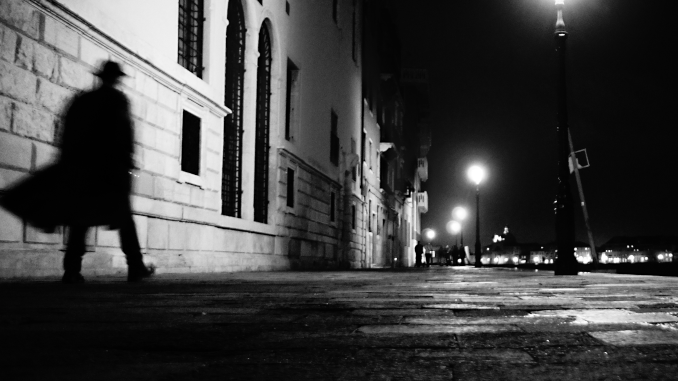
Today’s film is 1954’s “Scarlet Street,” starring Edward G. Robinson (Chris Cross), Joan Bennett (Katherine “Kitty” March), Dan Duryea (Johnny Prince), Rosalind Ivan (Adele Cross), Russell Hicks (J. J. Hogarth). Margaret Lindsay (Millie Ray), Jess Barker (David Janeway). Charles Kemper (Patch-Eye Higgins), Anita Sharp-Bolton (Mrs. Michaels), Samuel S. Hinds (Charles Pringle), Vladimir Sokoloff (Pop LeJon), Arthur Loft (Delarowe). Directed by Fritz Lang; cinematography (Director of Photography) by Milton R. Krasner. Produced by Diana Productions (Walter Wanger and Fritz Lang) and distributed by Universal Pictures. Screenplay by Dudley Nichols; based on the French play and novel “La Chienne” (The Bitch) by Georges de La Fouchardière (novel) and André Mouézy-Éon (play).
You can watch the trailer here:
I provided a link for the full movie at the top of this post, but there are plenty of postings of it on YouTube, in case that link stops working.
“La Chienne,” the source material for this Fritz Lang film, was also made into a French language film in 1931. And given that translates into “The Bitch,” you can probably guess that at the heart of this story lies a pretty terrible woman. And you’d be right, if that’s your guess. So we’re going to be seeing a lot of a very classic film noir type, the femme fatale, in this story.
Something else I’ve mentioned is that film noir is about the central character making a series of bad choices; Chris Cross is no exception to this rule. And usually in this genre, the bad choices the central character is making are driven by the femme fatale. Check, again.
The story begins with Chris being honored by his boss, J. J. Hogarth, for twenty-five years of faithful service to the store he owns. J. J. leaves the party early, sending the rest of the party guests to the window to see who might be meeting him outside. It’s a bleach-blonde floozy, less than half his age. Chris wistfully admits to his friend Charles Pringle that he couldn’t have even gotten a girl like that back when he was young, much less now that he’s an old man. Charles said we all have dreams and asks Chris what his dreams are. Chris replies that he once wanted to be a great painter and he still dabbles in the medium on the weekends.
In noir pictures, the central character really should be careful what he (or she) wishes for; Chris’s wish is certainly no exception.
As he’s heading home, Chris witnesses a young woman (Kitty March) being accosted by a young man (Johnny Prince) in the street. Chris rushes to her rescue and somehow manages to lay Johnny out on the sidewalk. Chris runs to fetch a policeman, leaving the girl and her attacker alone; but once he comes to, we realize that he’s the girl’s creep of a boyfriend who was trying to strongarm her for some money. (Which he apparently does a lot.) She tells him to clear out so that when Chris returns with the cop, she sends the officer in the wrong direction, while she and Chris also leave the scene.
Bad choice number one.
Chris walks Kitty home and the two end up in Tiny’s Bar, which is in the basement of the building where she lives. As they talk they both have mistaken impressions of the other — he guesses she’s an actress, and she guesses he must be a painter, since she met him in Greenwich Village. And Chris is more than happy to let her believe such a whopper of a lie. She even assumes, as the conversation continues, that Chris is wealthy enough to buy a $50,000 painting when he admits he’d like to own a Cezanne.
A few days later, Johnny notices there’s a letter to Kitty on her dresser. He opens and reads it; it’s from Chris, professing his feelings for the girl. She tells him it’s from the old man who saved her on Saturday, and Johnny sees an opportunity to exploit the old goof for money, and big money at that.
And thus the die is cast. A few innocent lies end up leading to larceny, blackmail, and murder.
The ending is counter to the Hays Code, in that the killer isn’t directly punished for the crime, but does end up suffering for that terrible sin, anyway, though it’s torment of a psychological rather than physical nature. And because of the ending, there were many states that initially banned the film on its release. But, finally, New York allowed the film to be shown, which led to all the other states allowing it. The public fight over it led to its box office success. (Well, that, and it’s a fine example of film noir.)
I give this film 4.75 unfiltered cigarette puffs (I knocked off the quarter puff for the brutality they showed that poor 1935 Super 8 Packard convertible Johnny drives around.)
You can see the Packard in question here.
Next week’s film is “Five Against the House”
This is an open thread, so feel free to discuss whatever you like in the comments below. And remember, when some cute young thing plays up to you, don’t buy into her flattery.
